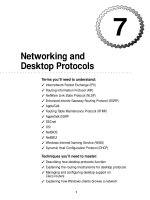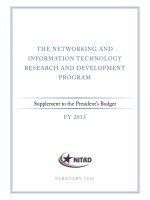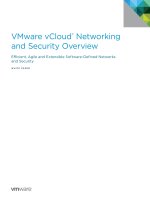Docker networking and service discovery
Bạn đang xem bản rút gọn của tài liệu. Xem và tải ngay bản đầy đủ của tài liệu tại đây (4.22 MB, 99 trang )
Docker Networking and Service
Discovery
Michael Hausenblas
Docker Networking and Service Discovery
by Michael Hausenblas
Copyright © 2016 O’Reilly Media, Inc. All rights reserved.
Printed in the United States of America.
Published by O’Reilly Media, Inc., 1005 Gravenstein Highway North,
Sebastopol, CA 95472.
O’Reilly books may be purchased for educational, business, or sales
promotional use. Online editions are also available for most titles
(). For more information, contact our
corporate/institutional sales department: 800-998-9938 or
Editor: Brian Anderson
Production Editor: Kristen Brown
Copyeditor: Jasmine Kwityn
Interior Designer: David Futato
Cover Designer: Karen Montgomery
Illustrator: Rebecca Demarest
February 2016: First Edition
Revision History for the First Edition
2016-01-11: First Release
The O’Reilly logo is a registered trademark of O’Reilly Media, Inc. Docker
Networking and Service Discovery, the cover image, and related trade dress
are trademarks of O’Reilly Media, Inc.
While the publisher and the author have used good faith efforts to ensure that
the information and instructions contained in this work are accurate, the
publisher and the author disclaim all responsibility for errors or omissions,
including without limitation responsibility for damages resulting from the use
of or reliance on this work. Use of the information and instructions contained
in this work is at your own risk. If any code samples or other technology this
work contains or describes is subject to open source licenses or the
intellectual property rights of others, it is your responsibility to ensure that
your use thereof complies with such licenses and/or rights.
978-1-491-95095-1
[LSI]
Preface
When you start building your applications with Docker, you’re excited about
the capabilities and opportunities you encounter: it runs the same in dev and
in prod, it’s straightforward to put together a Docker image, and the
distribution is taken care of by tools like the Docker hub. So, you’re satisfied
with how quickly you were able to port an existing, say, Python app, to
Docker and you want to connect it to another container that has a database,
such as PostgreSQL. Also, you don’t want to manually launch the Docker
containers and implement your own system that takes care of checking if the
containers are still running, and if not, relaunch them.
At this juncture, you realize there are two related challenges you’ve been
running into: networking and service discovery. Unfortunately, these two
areas are emerging topics, which is a fancy way of saying there are still a lot
of moving parts, and there are currently few best practice resources available
in a central place. Fortunately, there are tons of recipes available, even if they
are scattered over a gazillion blog posts and many articles.
The Book
So, I thought to myself: what if someone wrote a book providing some basic
guidance for these topics, pointing readers in the right direction for each of
the technologies?
That someone turned out to be me, and with this book I want to provide you
— in the context of Docker containers — with an overview of the challenges
and available solutions for networking as well as service discovery. I will try
to drive home three points throughout this book:
Service discovery and container orchestration are two sides of the same
coin.
Without a proper understanding of the networking aspect of Docker and a
sound strategy in place, you will have more than one bad day.
The space of networking and service discovery is young: you will find
yourself starting out with one set of technologies and likely change gears
and try something else; do not worry, you’re in good company and in my
opinion it will take another two odd years until standards emerge and the
market is consolidated.
ORCHESTRATION AND SCHEDULING
Strictly speaking, orchestration is a more general process than scheduling: it subsumes scheduling
but also covers other things, such as relaunching a container on failure (either because the
container itself became unhealthy or its host is in trouble). So, while scheduling really is only the
process of deciding which container to put on which host, I use these two terms interchangeably in
the book.
I do this because, first, because there’s no official definition (as in: an IETF RFC or a NIST
standard), and second, because the marketing of different companies sometimes deliberately mix
them up, so I want you to prepare for this. However, Joe Beda (former Googler and Kubernetes
mastermind), put together a rather nice article on this topic, should you wish to dive deeper:
“What Makes a Container Cluster?”
You
My hope is that the book is useful for:
Developers who drank the Docker Kool-Aid
Network ops who want to brace themselves for the upcoming onslaught of
their enthusiastic developers
(Enterprise) software architects who are in the process of migrating
existing workloads to Docker or starting a new project with Docker
Last but not least, I suppose that distributed application developers, SREs,
and backend engineers can also extract some value out of it.
Note that this is not a hands-on book — besides the basic Docker networking
stuff in Chapter 2 — but more like a guide. You will want to use it to make
an informed decision when planning Docker-based deployments. Another
way to view the book is as a heavily annotated bookmark collection.
Me
I work for a cool startup called Mesosphere, Inc. (the commercial entity
behind Apache Mesos), where I help devops to get the most out of the
software. While I’m certainly biased concerning Mesos being the best current
option to do cluster scheduling at scale, I will do my best to make sure
throughout the book that this preference does not negatively influence the
technologies discussed in each section.
Acknowledgments
Kudos to my Mesosphere colleagues from the Kubernetes team: James
DeFelice and Stefan Schimanski have been very patient answering my
questions around Kubernetes networking. Another round of kudos go out to
my Mesosphere colleagues (and former Docker folks) Sebastien Pahl and
Tim Fall — I appreciate all of your advice around Docker networking very
much! And thank you as well to Mohit Soni, yet another Mesosphere
colleague who took time out of his busy schedule to provide feedback!
I further would like to thank Medallia’s Thorvald Natvig, whose Velocity
NYC 2015 talk triggered me to think deeper about certain networking
aspects; he was also kind enough to allow me to follow up with him and
discuss motivations of and lessons learned from Medallia’s
Docker/Mesos/Aurora prod setup.
Thank you very much, Adrian Mouat (Container Solutions) and Diogo
Mónica (Docker, Inc.), for answering questions via Twitter, and especially
for the speedy replies during hours where normal people sleep, geez!
I’m grateful for the feedback I received from Chris Swan, who provided clear
and actionable comments throughout, and by addressing his concerns, I
believe the book became more objective as well.
Throughout the book writing process, Mandy Waite (Google) provided
incredibly useful feedback, particularly concerning Kubernetes; I’m so
thankful for this and it certainly helped to make things clearer. I’m also
grateful for the support I got from Tim Hockin (Google), who helped me
clarify the confusion around the new Docker networking features and
Kubernetes.
Thanks to Matthias Bauer, who read an early draft of this manuscript and
provided great comments I was able to build on.
A big thank you to my O’Reilly editor Brian Anderson. From the first
moment we discussed the idea to the drafts and reviews, you’ve been very
supportive, extremely efficient (and fun!), and it’s been a great pleasure to
work with you.
Last but certainly not least, my deepest gratitude to my awesome family: our
“sunshine” Saphira, our “sporty girl” Ranya, our son and “Minecraft master”
Iannis, and my ever-supportive wife Anneliese. Couldn’t have done this
without you and the cottage is my second-favorite place when I’m at home. ;)
Chapter 1. Motivation
In February 2012, Randy Bias gave an impactful talk on architectures for
open and scalable clouds. In his presentation, he established the pets versus
cattle meme:1
With the pets approach to infrastructure, you treat the machines as
individuals. You give each (virtual) machine a name and applications are
statically allocated to machines. For example, db-prod-2 is one of the
production servers for a database. The apps are manually deployed and
when a machine gets ill you nurse it back to health and again manually
redeploy the app it ran onto another machine. This approach is generally
considered to be the dominant paradigm of a previous (non-cloud-native)
era.
With the cattle approach to infrastructure, your machines are anonymous,
they are all identical (modulo hardware upgrades), have numbers rather
than names, and apps are automatically deployed onto any and each of the
machines. When one of the machines gets ill, you don’t worry about it
immediately, and replace it (or parts of it, such as a faulty HDD) when
you want and not when things break.
While the original meme was focused on virtual machines, we apply the
cattle approach to infrastructure to containers.
Go Cattle!
The beautiful thing about applying the cattle approach to infrastructure is that
it allows you to scale out on commodity hardware.2
It gives you elasticity with the implication of hybrid cloud capabilities. This
is a fancy way of saying that you can have a part of your deployments on
premises and burst into the public cloud (as well as between IaaS offerings of
different providers) if and when you need it.
Most importantly, from an operator’s point of view, the cattle approach
allows you to get a decent night’s sleep, as you’re no longer paged at 3 a.m.
just to replace a broken HDD or to relaunch a hanging app on a different
server, as you would have done with your pets.
However, the cattle approach poses some challenges that generally fall into
one of the following two categories:
Social challenges
I dare say most of the challenges are of a social nature: How do I
convince my manager? How do I get buy-in from my CTO? Will my
colleagues oppose this new way of doing things? Does this mean we will
need less people to manage our infrastructure? Now, I will not pretend
to offer ready-made solutions for this part; instead, go buy a copy of The
Phoenix Project, which should help you find answers.
Technical challenges
In this category, you will find things like selection of base provisioning
mechanism of the machines (e.g., using Ansible to deploy Mesos
Agents), how to set up the communication links between the containers
and to the outside world, and most importantly, how to ensure the
containers are automatically deployed and are consequently findable.
Docker Networking and Service Discovery
Stack
The overall stack we’re dealing with here is depicted in Figure 1-1 and is
comprised of the following:
The low-level networking layer
This includes networking gear, iptables, routing, IPVLAN, and Linux
namespaces. You usually don’t need to know the details here, unless
you’re on the networking team, but you should be aware of it. See
Chapter 2 for more information on this topic.
A Docker networking layer
This encapsulates the low-level networking layer and provides some
abstractions such as the single-host bridge networking mode or a
multihost, IP-per-container solution. I cover this layer in Chapters 2 and
3.
A service discovery/container orchestration layer
Here, we’re marrying the container scheduler decisions on where to
place a container with the primitives provided by lower layers.
Chapter 4 provides you with all the necessary background on service
discovery, and in Chapter 5, we look at networking and service
discovery from the point of view of the container orchestration systems.
SOFTWARE-DEFINED NETWORKING (SDN)
SDN is really an umbrella (marketing) term, providing essentially the same advantages to
networks that VMs introduced over bare-metal servers. The network administration team becomes
more agile and can react faster to changing business requirements. Another way to view it is: SDN
is the configuration of networks using software, whether that is via APIs, complementing NFV, or
the construction of networks from software; the Docker networking provides for SDN.
Especially if you’re a developer or an architect, I suggest taking a quick look at Cisco’s nice
overview on this topic as well as SDxCentral’s article “What’s Software-Defined Networking
(SDN)?”
Figure 1-1. Docker networking and service discovery (DNSD) stack
If you are on the network operations team, you’re probably good to go for the
next chapter. However, if you’re an architect or developer and your
networking knowledge might be a bit rusty, I suggest brushing up your
knowledge by studying the Linux Network Administrators Guide before
advancing.
Do I Need to Go “All In”?
Oftentimes when I’m at conferences or user groups, I meet people who are
very excited about the opportunities in the container space but at the same
time they (rightfully) worry about how deep they need to commit in order to
benefit from it. The following table provides an informal overview of
deployments I have seen in the wild, grouped by level of commitment
(stages):
Stage
Typical Setup
Traditional Bare-metal or VM, no containers
Examples
Majority of today’s prod
deployments
Simple
Manually launched containers used for app-level dependency Development and test
management
environments
Ad hoc
A custom, homegrown scheduler to launch and potentially
restart containers
Full-blown An established scheduler from Chapter 5 to manage
containers; fault tolerant, self-healing
RelateIQ, Uber
Google, Zulily,
Gutefrage.de
Note that not all of these examples use Docker containers (notably, Google
does not) and that some start out, for instance, in the ad-hoc stage and are
transitioning to a full-blown stage as we speak (Uber is such a case; see this
presentation from ContainerSched 2015 in London). Last but not least, the
stage doesn’t necessarily correspond with the size of the deployment. For
example, Gutefrage.de only has six bare-metal servers under management,
yet uses Apache Mesos to manage them.
One last remark before we move on: by now, you might have already realized
that we are dealing with distributed systems in general here. Given that we
will usually want to deploy containers into a network of computers (i.e., a
cluster), I strongly suggest reading up on the fallacies of distributed
computing, in case you are not already familiar with this topic.
And now, without further ado, let’s jump into the deep end with Docker
networking.
1
In all fairness, Randy did attribute the origins to Bill Baker of Microsoft.
2
Typically even very homogenous hardware — see, for example, slide 7 of the PDF slide deck for
Thorvald Natvig’s Velocity NYC 2015 talk “Challenging Fundamental Assumptions of
Datacenters: Decoupling Infrastructure from Hardware”.
Chapter 2. Docker Networking
101
Before we get into the networking side of things, let’s have a look at what is
going on in the case of a single host. A Docker container needs a host to run
on. This can either be a physical machine (e.g., a bare-metal server in your
on-premise datacenter) or a VM either on-prem or in the cloud. The host has
the Docker daemon and client running, as depicted in Figure 2-1, which
enables you to interact with a Docker registry on the one hand (to pull/push
Docker images), and on the other hand, allows you to start, stop, and inspect
containers.
Figure 2-1. Simplified Docker architecture (single host)
The relationship between a host and containers is 1:N. This means that one
host typically has several containers running on it. For example, Facebook
reports that — depending on how beefy the machine is — it sees on average
some 10 to 40 containers per host running. And here’s another data point: at
Mesosphere, we found in various load tests on bare metal that not more than
around 250 containers per host would be possible.1
No matter if you have a single-host deployment or use a cluster of machines,
you will almost always have to deal with networking:
For most single-host deployments, the question boils down to data
exchange via a shared volume versus data exchange through networking
(HTTP-based or otherwise). Although a Docker data volume is simple to
use, it also introduces tight coupling, meaning that it will be harder to turn
a single-host deployment into a multihost deployment. Naturally, the
upside of shared volumes is speed.
In multihost deployments, you need to consider two aspects: how are
containers communicating within a host and how does the communication
paths look between different hosts. Both performance considerations and
security aspects will likely influence your design decisions. Multihost
deployments usually become necessary either when the capacity of a
single host is insufficient (see the earlier discussion on average and
maximal number of containers on a host) or when one wants to employ
distributed systems such as Apache Spark, HDFS, or Cassandra.
DISTRIBUTED SYSTEMS AND DATA LOCALITY
The basic idea behind using a distributed system (for computation or storage) is to benefit from
parallel processing, usually together with data locality. By data locality I mean the principle to
ship the code to where the data is rather than the (traditional) other way around. Think about the
following for a moment: if your dataset size is in the TB and your code size is in the MB, it’s
more efficient to move the code across the cluster than transferring TBs of data to a central
processing place. In addition to being able to process things in parallel, you usually gain fault
tolerance with distributed systems, as parts of the system can continue to work more or less
independently.
This chapter focuses on networking topics for the single-host case, and in
Chapter 3, we will discuss the multihost scenarios.
Simply put, Docker networking is the native container SDN solution you
have at your disposal when working with Docker. In a nutshell, there are four
modes available for Docker networking: bridge mode, host mode, container
mode, or no networking.2 We will have a closer look at each of those modes
relevant for a single-host setup and conclude at the end of this chapter with
some general topics such as security.
Bridge Mode Networking
In this mode (see Figure 2-2), the Docker daemon creates docker0, a virtual
Ethernet bridge that automatically forwards packets between any other
network interfaces that are attached to it. By default, the daemon then
connects all containers on a host to this internal network through creating a
pair of peer interfaces, assigning one of the peers to become the container’s
eth0 interface and other peer in the namespace of the host, as well as
assigning an IP address/subnet from the private IP range to the bridge
(Example 2-1).
Example 2-1. Docker bridge mode networking in action
$ docker run -d -P --net=bridge nginx:1.9.1
$ docker ps
CONTAINER ID IMAGE
COMMAND
CREATED
STATUS
PORTS
NAMES
17d447b7425d nginx:1.9.1
nginx -g
19 seconds ago
Up 18 seconds 0.0.0.0:49153->443/tcp,
0.0.0.0:49154->80/tcp trusting_feynman
NOTE
Because bridge mode is the Docker default, you could have equally used docker run -d
-P nginx:1.9.1 in Example 2-1. If you do not use -P (which publishes all exposed ports
of the container) or -p host_port:container_port (which publishes a specific port),
the IP packets will not be routable to the container outside of the host.
Figure 2-2. Bridge mode networking setup
TIP
In production, I suggest using the Docker host mode (discussed in “Host Mode
Networking”) along with one of the SDN solutions from Chapter 3. Further, to influence
the network communication between containers, you can use the flags --iptables and icc.
Host Mode Networking
This mode effectively disables network isolation of a Docker container.
Because the container shares the networking namespace of the host, it is
directly exposed to the public network; consequently, you need to carry out
the coordination via port mapping.
Example 2-2. Docker host mode networking in action
$ docker run -d --net=host ubuntu:14.04 tail -f /dev/null
$ ip addr | grep -A 2 eth0:
2: eth0: <BROADCAST,MULTICAST,UP,LOWER_UP> mtu 9001 qdisc mq state UP group default
qlen 1000
link/ether 06:58:2b:07:d5:f3 brd ff:ff:ff:ff:ff:ff
inet **10.0.7.197**/22 brd 10.0.7.255 scope global dynamic eth0
$ docker ps
CONTAINER ID IMAGE
COMMAND CREATED
STATUS
PORTS
NAMES
b44d7d5d3903 ubuntu:14.04 tail -f 2 seconds ago
Up 2 seconds
jovial_blackwell
$ docker exec -it b44d7d5d3903 ip addr
2: eth0: <BROADCAST,MULTICAST,UP,LOWER_UP> mtu 9001 qdisc mq state UP group default
qlen 1000
link/ether 06:58:2b:07:d5:f3 brd ff:ff:ff:ff:ff:ff
inet **10.0.7.197**/22 brd 10.0.7.255 scope global dynamic eth0
And there we have it: as shown in Example 2-2, the container has the same IP
address as the host, namely 10.0.7.197.
In Figure 2-3, we see that when using host mode networking, the container
effectively inherits the IP address from its host. This mode is faster than the
bridge mode (because there is no routing overhead), but it exposes the
container directly to the public network, with all its security implications.
Figure 2-3. Docker host mode networking setup









